https://www.nachi.org › roofs.htm

A drone roof inspection might look high-tech, but it can’t replace a physical roof inspection by a qualified roof inspector. Learn the key differences and why walking the roof is still essential for detecting roof damage.
Why You Should Always Choose a Physical Roof Inspection Over a Drone Flyover
Drones have quickly become a go-to tool in the home inspection and roofing industries. They provide a fast and relatively safe way to check out a home’s roof—especially when it’s steep or hard to access. But while drone inspections offer convenience and flashy photos, they can’t match the detail, accuracy, and hands-on expertise of a physical roof inspection.
Here’s why it’s still crucial to have a qualified roof inspector walk your roof—especially when buying a home, preparing for a sale, or dealing with storm-related roof damage.
1. Physical Roof Inspections Detect What Drones Can’t
A drone roof inspection gives you a bird’s-eye view—but that only tells part of the story. An inspector walking the roof can:
-
Feel for soft decking or water-damaged areas
-
Spot minor granule loss on asphalt shingles
-
Identify lifting shingles, unsealed flashing, or rusty nails
-
Smell mold or mildew, especially near vents or chimneys
These subtle clues are often missed during drone flyovers. In many cases, early detection of issues like these can save homeowners thousands in repairs.
2. Close-Up Detail Equals Better Reporting
Drones can take high-resolution images, but they still operate at a distance. A human roof inspector can get up close—examining every vent, flashing joint, and ridge cap. That means they’re more likely to catch small but serious problems like:
-
Hairline cracks in tiles or shingles
-
Inadequate sealing around roof penetrations
-
Improper installation or aging materials
These issues might not be obvious on video but can lead to costly leaks or structural damage if left unaddressed.
3. Expertise Matters: Judgment You Can Trust
A certified roof inspector doesn’t just look at the roof—they interpret what they see. They bring years of hands-on experience and can assess:
-
The overall lifespan of the roofing system
-
Whether an issue is cosmetic or structurally significant
-
What immediate action (if any) is needed
A drone can’t make professional judgments. And it definitely can’t talk to a homeowner in real-time to explain what’s going on or answer urgent questions.
4. Real-Time, Interactive Problem Solving
When a roof is walked, the inspector can do more than observe. They can:
-
Trace signs of leaks to their source
-
Test flashing and seals by hand
-
Check the condition of fasteners and underlayment
-
Spot potential issues with attic ventilation and moisture buildup
This type of hands-on roof inspection offers far more value than drone footage alone—especially during a real estate transaction or insurance claim.
5. Drone Inspections Have Their Place—but Also Limits
Drones are useful, especially in situations where the roof is too steep, icy, or otherwise unsafe to walk. They’re also great for capturing aerial views for marketing or presentations. However, they come with clear limitations:
-
Can’t detect tactile issues like soft decking or loose shingles
-
Can’t access tight spaces or inspect under overhangs
-
May be restricted by weather, FAA regulations, or local ordinances
That’s why a drone should be used as a supplementary tool, not a replacement for a full roof inspection by a qualified professional.
When Should You Use Each Method?
Here’s a quick breakdown:
| Method | Best For | Limitations |
|---|---|---|
| Drone Inspection | Quick visual overview, unsafe roofs, marketing photos | Limited detail, no tactile feedback |
| Physical Roof Inspection | In-depth evaluation, home sales, storm damage claims | Requires roof access and favorable conditions |
For the most accurate results, many top roofing contractors and home inspection companies use both methods—starting with a drone to survey, then walking the roof for a full diagnosis.
Final Thoughts: Don’t Settle for a Flyover
A drone might be a powerful tool, but it’s just that—a tool. The real value comes from the experienced roof inspector behind the inspection. If you’re relying solely on drone footage, you could be missing major roofing issues that lead to expensive repairs down the road.
Always ask your inspector if they walk the roof. If they don’t, you may want to keep looking.
Call to Action:
Need a comprehensive roof inspection? Our certified inspectors walk every roof (when safe to do so) and use drone technology to supplement—not substitute—our work. Contact us today for a full home or roof inspection you can trust.

